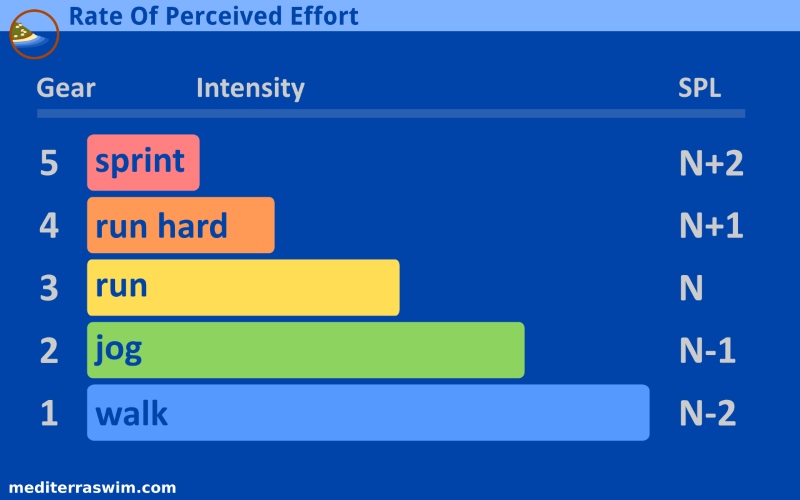Forums › Library › Knowledge Base › Rate Of Perceived Effort Scale (RPE)
Please type your comments directly in the reply box - DO NOT copy/paste text from somewhere else into the reply boxes - this will also copy the code behind your copied text and publish that with your reply, making it impossible to read. Our apology for the inconvenience, but we don't see a convenient way of fixing this yet.
Tagged: perceived effort, rpe, SPL
-
AuthorPosts
-
August 1, 2014 at 14:43 #2609
Admin Mediterra
Keymaster
RPE Quick DefinitionsRPE #1 is like WALKING. You can maintain your best technique at this Pace with little concentration, and hold about SPL N-2, or near the lowest point of your Optimal Green Zone. You can swim ‘endlessly’ at this Pace.
RPE #2 is like JOGGING. You can maintain your best technique, with concentration. SPL is N to N-1. You could hold this Pace for 100% of your racing distance, and use it for recovery in the middle of a race.
RPE #3 is like RUNNING or CRUISING comfortably. You can maintain good technique, with strong concentration. SPL is up to N. You could hold this Pace for 100% of your racing distance.
RPE #4 is like RUNNING HARD, near your top aerobic capacity. You can maintain good technique, with strong concentration. SPL is up to N+1. You could hold this Pace for 70% or more of your racing distance.
RPE #5 is like SPRINTING, in your anaerobic zone while maintaining good technique with extreme concentration. SPL is up to N+2 or even N+3. You could hold this Pace only for up to 20% of your racing distance, at starts and finishes and occasional tactical sprints.
Coach Terry’s Description of the RPE Levels
Rate of Perceived Exertion (RPE) is as essential a measure as SPL in pursuing Easy Speed. Traditional RPE scales (the most widely-used is the 10-point Borg scale) measure only exercise intensity. At the low end, you’re barely using any effort. At the top end, you experience significant discomfort and feel on the verge of exhaustion.
TI recommends a 5-point scale with two critical modifications:
1. The top level of the TI-RPE scale represents the maximal effort you can expend *while avoiding excessive energy waste*. For most people, this is far below maximal effort.
You can easily link the TI-RPE and TI-SPL scales as both have 5 values.
- At RPE-1, you should easily be able to maintain the lowest stroke count in your personal SPL range for short distances.
- At RPE-5, take care not to exceed the highest count in your range. In other words, never swim so hard that you exceed your current level of skill or coordination.
2. The TI-RPE scale focuses primarily on functional goals rather than effort/intensity goals. Every task or set should have a clear skill (or race-rehearsal) goal. If you focus primarily on that—and use SPL as a cross-reference—you should be able to create a personalized TI-RPE scale fairly quickly.
RPE-1 Perfect
At this nearly effortless level, you feel capable of swimming with nearly perfect technique and your highest level of efficiency. RPE-1 is ideal for skill improvement, tuneup at the start of practice and recovery/restoration between efforts at the RPE-4 and above level. RPE-1 should be equivalent to walking pace on land. (Note: You must have good Balance and Stability skills to access this level of ease.)
RPE-2 Cruise
At this light effort—moderately faster than tuneup/warmup pace—you can maintain a high level of efficiency (traveling 65% or more of height on each stroke) for relatively long sets or swims. If you were running RPE-2 would be the equivalent of an easy jog. This is the optimal effort level for a beginner triathlete or the first quarter of a tri or open water swim.
RPE-3 Brisk
At this effort level, you can maintain solid efficiency (3rd and 4th counts in your 5-count SPL range) . . . so long as you maintain keen focus. You’re well within your comfort zone, but ‘aware’ of its edge.
RPE-3 is a good training zone for testing and developing your ability to stay efficient in longer (1km/20 min or more) timed swims or races. If your goal is to swim a strong, steady pace at RPE-2 during a 1.5k tri swim, you can improve the pace you’ll hold there by swimming pool repeats of two to three minutes with relatively brief rest at RPE-3, then gradually extending those repeats to 5 to 10 minutes with no loss of efficiency. If you were running, RPE-3 would be a conversational pace—but perhaps not long-winded conversation.
RPE-4 Fast
RPE-4 represents how you’d like to feel during a strongly-paced segment of a race, perhaps the final 300-500m of a 1.5k. Though somewhat intense, RPE-4 should feel great on the whole—using your body at its peak capacity, but using it well! In pool practice, RPE-4 repeats will generally be 200y/m or shorter with active rest (i.e. an equal amount of ‘recovery’ swimming at RPE-1 to RPE-2). Strive to maintain an SPL one to two strokes below the highest count in your range.
RPE-5 Fast+
RPE-5 is intended mainly for those who are quite serious about performance. It prepares you for relatively brief and specific segments of a race. In open water that could be the initial sprint of 50 to 100 meters to the first turn buoy, or the final 100 to 200 meters if you find yourself in a head-to-head dual with a rival. A critical discipline when swimming at this level—still a bit below your maximum—is to avoid exceeding the highest SPL in your range.
-
AuthorPosts
- The topic ‘Rate Of Perceived Effort Scale (RPE)’ is closed to new replies.
